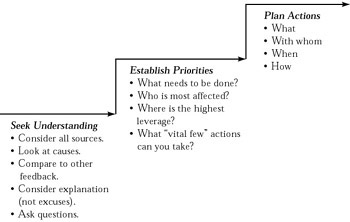Step 3: Reflect
We know we’ve emphasized this step in many of the passages, but it is the basis for leadership learning and the way to avoid repeating an experience. If you don’t understand why you are succeeding, you’re operating at the level of an efficient machine, not an effective leader. If you don’t understand why you failed, you are vulnerable to the recurrence of the same events.
Reflection facilitates understanding. Almost all the leaders we interviewed talked about the importance of reflection, though they didn’t always use this term. One executive, a former military officer, for instance, referred to “After Action Review”—a process by which commanders analyze what went right and wrong after a military engagement. He routinely did the same thing in the business world. If you recall David Kolb’s learning theory, presented in Chapter Two, you’ll understand how reflection is absolutely essential to learning. Although some of us are more inclined to reflect than others, everyone can make it a conscious part of their response to each passage.
During Action Learning programs, executives participate together in addressing a current business or strategy challenge for the corporation. What differentiates Action Learning from working on a task team is the process of reflecting and then engaging in self- and team challenge. This accelerates learning, encourages self-insight, and creates the conditions for leadership growth. But you don’t need to participate in an Action Learning program to reap the same benefits. Make reflection part of your everyday repertoire, rigorously challenge old assumptions, review the action once it’s over, and you’ll make yourself a better leader.
After an event triggers a passage in your life, ask yourself the same questions an executive coach might ask you:
Why did this happen to me (or to someone I care about)?
Did my actions or attitudes contribute in some way to the event?
If I had acted differently, might the event have turned out differently?
Do I feel angry, sad, or guilty about what took place? Why?
If I could turn back the clock and change something I said or did, what would it be?
These and similar types of questions will give you the material to reflect on in every passage (see Figure 17.1 for more ideas).

Figure 17.1: Three Steps to Enhancing Leadership Effectiveness Through Reflection.
EAN: 2147483647
Pages: 121